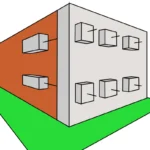Construction Project Lifecycle
The construction project lifecycle consists of four main phases: feasibility, planning and design, construction, and operation (commissioning). In this cycle, the civil engineer plays a crucial role, especially in the aspects of planning, design, and construction.
In the feasibility phase, the project is detailed, establishing the overall objective and specific goals to achieve. The need for the project is justified, and costs and budgets are outlined, evaluating financial feasibility through a co-financing matrix. This stage also includes defining the project schedule, which sets the necessary timelines for each phase and activity of the feasibility, planning, and design stages.
The planning and design of a construction project focus on shaping and detailing the project’s vision. Here, final designs are developed, including architectural plans, structural designs, facilities, and more. Contractual documents are also created, and the bidding process is planned for selecting the construction contractor and supervision.
Execution is the moment when everything becomes a reality. It begins with the actual construction, where surveying is carried out, and the physical work is realized. Control and monitoring processes are established to ensure that the project progresses according to the plan.
Finally, in the commissioning phase, the project is handed over to service, with prior quality checks. Additionally, operation and maintenance of the structure are considered, a crucial stage for its long-term durability and proper functioning.

Feasibility: The Foundation of a Solid Project
The feasibility phase is the foundation upon which the entire project will be built. Here, the project is detailed, establishing the overall objective and specific goals to achieve. The project’s scope, justification, and estimated costs and budgets for the feasibility, planning, and design stage are analyzed. A co-financing matrix can be used to evaluate the financial viability of the project, and the conclusions and recommendations from this comprehensive analysis are presented.
The project schedule sets the necessary timelines for each of the phases and activities of the feasibility and planning and design stages. This allows for effective and realistic planning of the deadlines to be followed throughout the project’s development.
The stage of preliminary studies and designs is a crucial element in determining the viability and feasibility of the project. Various studies are conducted, depending on the project’s scale and characteristics, including geomorphological, seismic, soil, topographical, real estate, socioeconomic, market, traffic and transportation, hydrological and hydraulic, and environmental impact aspects. Preliminary architectural, structural, hydraulic, sanitary, mechanical designs are also prepared, and preliminary budgets are established. The information obtained in this phase is critical for determining whether the project is viable or feasible to proceed to the next stage.
Construction Project Formulation
It includes the following points:
– Overall project objective.
– Specific objectives.
– Scope.
– Justification.
– Detailed costs and budget for the feasibility, planning, and design stage.
– Co-financing matrix.
– Conclusions and recommendations.
Construction Project Schedule
The Project Schedule is an essential tool in the planning and management of any project, including those related to construction. It consists of a detailed and sequential representation of the various phases and activities that make up the project, establishing the start and completion dates for each of them.
In the specific case of the Feasibility and Planning and Design stages in a construction project, the Schedule plays a crucial role in defining the necessary time for carrying out the activities related to these two fundamental stages.
Preliminary Studies and Designs
– Geomorphological and seismic studies.
– Soil studies.
– Topographical studies.
– Real estate studies: for land use or acquisition.
– Socioeconomic studies.
– Market studies.
– Traffic and transportation studies.
– Hydrological and hydraulic studies.
– Environmental impact studies.
– Preliminary architectural designs.
– Preliminary structural designs.
– Preliminary hydraulic and sanitary designs.
– Preliminary mechanical designs.
– Preliminary budgets.
Depending on these studies and designs, it is determined whether the project in this phase is viable or feasible to proceed to the next stage.
Planning and Designs
The planning and design phase is the moment when the project’s vision takes shape and becomes a detailed plan for its realization. Here, final designs are developed, including architectural plans, structural, hydraulic, sanitary, mechanical, and electrical designs. Special installations such as gas and information and communications technology (ICT) are also considered, and roads and pavements are designed. Technical specifications are established, and work quantities and budget are calculated. Additionally, a construction schedule is programmed, allowing for precise planning of all activities involved.
The necessary contractual documents are generated for the selection of the construction contractor and supervision. The terms of reference for the bidding process and the schedule for that process are essential to ensure a suitable and transparent selection process.
Construction planning is a key element in ensuring efficiency and effectiveness in the execution of the project. Here, the strategic plan, technical and administrative operational processes required for optimal construction are planned and organized.
The selection of the construction contractor and supervision is an essential step in ensuring that the right professionals and companies are responsible for the project’s execution and oversight. Through a bidding process, proposals are evaluated, and the most suitable contractor is selected for the project. The signing of the contract with the contractor and the supervisor establishes the basis for a collaborative and successful work.
Final Designs for the Construction Project
– Architectural designs.
– Structural designs.
– Hydraulic and sanitary designs.
– Mechanical designs.
– Electrical designs and special installations such as gas, ICT.
– Road and pavement designs.
– Technical specifications.
– Calculation of work quantities and budget.
– Work schedule or construction schedule.
Contractual Documents
– Terms of reference for the bidding process.
– Schedule for the bidding process.
Construction Planning
– Planning of the bidding process.
– Planning and organization of the strategic plan.
– Planning and organization of technical operational processes.
– Planning and organization of administrative operational processes.
Selection of the Construction Contractor and Supervision
– Bidding process: Site visit, proposal submission, technical-legal evaluation of proposals.
– Contractor selection.
– Contract signing.
Construction Execution
The execution of the construction is the phase in which everything comes to life. It is the moment to physically carry out the work, bringing the previously developed plans and designs to fruition. It starts with surveying, and construction is set in motion, with meticulous attention to detail and work quality.
During construction, a well-defined management and quality strategy is followed. Necessary permits are obtained for the work, and a contract is established that defines deadlines, costs, and the relationships between the project owner and the contractor. Efficient work methodologies are applied, and resources available throughout the construction are planned and scheduled.
Control and monitoring are essential elements in this phase to ensure that the project progresses as planned. The work accomplished is compared to the established objectives, and corrective measures are applied if necessary. Control can be internal, through self-control, external, by consultants hired by the client, or a combination of both to ensure quality and compliance with standards.
In addition to physical construction, work and contract closeouts are carried out. This final stage allows for the evaluation of the achieved results and ensures the proper closure of the work and contractual agreements.
In summary, the construction project’s lifecycle is a rigorous and transformative process that involves detailed planning, careful design, and efficient execution to turn an idea into a tangible reality. The civil engineer plays a central role in each of the phases, ensuring the success and quality of the project throughout its journey.
Bibliography
Books:
– Project Management in Construction, by John Wiley & Sons, Inc.
– The Business of Construction, by McGraw-Hill Education
– Construction Project Management: A Practical Guide to Planning, Organizing, and Managing Construction Projects, by John Wiley & Sons, Inc.
Articles:
– “The Project Life Cycle: A Guide for Construction Professionals,” by The American Institute of Architects
– “The Construction Project Management Process,” by The Project Management Institute
– “A Guide to the Project Management Body of Knowledge (PMBOK® Guide),” by The Project Management Institute
About The Author
Samuel Parariá
Estudio: University of Francisco de Paula Santander.
Major: Civil Engineering.
Favorite Areas: Structures, Traffic Engineering, and Road Design.
Location: Cúcuta, Norte de Santander, Colombia.







Related
Gravity Retaining Walls
What are Anchored Retaining Walls?
Methods for Paver Calculation – Civil Engineering